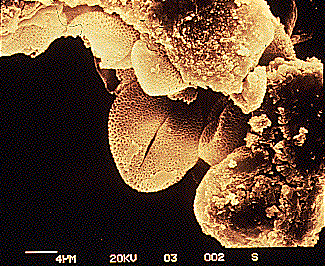Molecular fossils
Fossils: Window to the pastMolecular FossilsWhat is a molecular fossil?Until relatively recently, technology has not been capable of analyzing the molecular structures of fossils. The field of molecular fossil study has only been accessible to scientists within the last few years. Thus, little is known about the molecular fossil record. A molecular fossil is simply preserved organic material that has been transformed into fossils or has mostly decayed. This type of fossil is very delicate as it is based on the same molecular structures that made up the organism. It is therefore highly susceptible to decay as chemical reactions break apart the bonds that hold the molecule together. However, traces of organic molecules can still be found. As technology advances, more will be uncovered. There are four main groups of organic molecules preserved in the fossil record: nucleic acids (which include deoxyribonucleic acids (DNA) and ribonucleic acids (RNA)), proteins, carbohydrates, and lipids. Other organic molecules often exist that could be better preserved. But here, we will mainly focus on the organic molecules which are common among all (or at least most) organisms. Nucleic acids could tell us the most about the dead organism that left them behind, but they are extremeley fragile. DNA and RNA have reactive bonds that are easily hydrolyzed. Degradation of these molecules begin soon after a cell dies, so there is very little chance of preservation. Even so, the technique of polymerase chain reaction (PCR) can be used to analyze these molecules. This is a technique where specific sequences in the DNA or RNA are amplified for analysis. It has also been used to fit together separate fragments of sequences that overlap to form a more complete sequence. Think of this as a jigsaw puzzle where you have extra pieces. As you put together different parts of the jigsaw to form the picture, you notice that some parts overlap. Removing the overlapping pieces from one portion allows you to form a more complete picture with the two pieces. This is an example of how advancing technology is improving the study of molecular fossils. Nucleic acids have been found mostly in Miocene plants. Proteins are most abundant in animals, but the twenty amino acids contained in them can be found in any species. Proteins often form very complex, three-dimensional shapes that fold back on themselves to allow for hydrogen bonding and cross-linking between adjacent atoms. Thus, it is a more rigid compound than DNA or RNA. To be better preserved, it should be encased in biomineral crystalline structures where it can be isolated from decaying chemical reactions. Carbohydrates consist of monosaccharides and polysaccharides. Monosaccharides
are the simpler of the two compounds. Polysaccharides
are more Of the four main groups of organic molecules, Lipids are the most resistant to decay. They are also highly insoluble in water. All cells produce this type of organic compound to be used in their membranes and in energy storage. These type of organic molecules are found in kerogens (explained below). What are the conditions for molecular fossilization?Since all of these molecules are susceptible to some degree of decay, they would be preserved best in isolated areas. Different molecules have different requirements for preservation, but almost all would welcome little contact with air and microorganisms. Temperature and oxygen levels are also factors. The best places to find these type of fossils are (in increasing order of abundance): fossil shells and bones, organic-rich muds and shales, coal, and kerogens. Kerogens can be described as "poorly characterized, highly heterogeneous, amorphous, insoluble polymeric material found in the geological record." Kerogens, in fact, carry just over 80% of the organic molecules found in the fossil record. What can we learn from molecular fossils?Since little is still known about the molecular fossil record, little can be told. Some evolutionary relationships can be cleared by molecular analysis of fossils. However, contamination of specimens is still a large problem in today's analyses. Contamination can come from touching the sample (finger grease), the organic material of their containers (especially plastic), airborne microorganisms, and chemical reactions. In fact, contamination can result from the initial exposure to the air. Thus, special precautions are imperative to molecular fossil research. |
 complex.
Polysaccharides include starch and cellulose, found mainly in plants. Other
carbohydrates include glycogen, chitin, and other simple sugars (which
can be found in all organisms). They too are more likely to resist chemical
decay than nucleic acids. However, they are also more prone to other
organisms' use (specifically by microorganisms), causing
biological decay,. This can be described recycling back into the ecosphere.
Like proteins, they are easily degradable with water soluble components. Most
carbohydrates are from the Cenozoic, though there have been evidence for
carbohydrates dating from the Cambrian and Precambrian.
complex.
Polysaccharides include starch and cellulose, found mainly in plants. Other
carbohydrates include glycogen, chitin, and other simple sugars (which
can be found in all organisms). They too are more likely to resist chemical
decay than nucleic acids. However, they are also more prone to other
organisms' use (specifically by microorganisms), causing
biological decay,. This can be described recycling back into the ecosphere.
Like proteins, they are easily degradable with water soluble components. Most
carbohydrates are from the Cenozoic, though there have been evidence for
carbohydrates dating from the Cambrian and Precambrian.